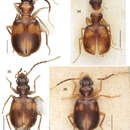Description
(
英語
)
由Zookeys提供
(Figs 33, 60). Habitus: (Fig. 33). Size: [See also Table 5] Small to large-sized for the genus; ABL = 2.336–3.78 mm, SBL = 2.265–3.736 mm, TW (total width) 1.382–2.216 mm, LP = 0.481–1.016 mm, WP = 0.659–1.065 mm, LE = 1.440–2.381 mm. Color: See diagnosis above. Luster: See diagnosis above. Head (Fig. 33): as in description for genus above. Prothorax. Pronotum (Fig. 33) moderately broad, as wide as head across eyes (WH/WP, mean both sexes: 1.002), larger than head (LP/LH, mean both sexes: 1.512), about as wider than long (WP/LP, mean both sexes: 1.381); markedly cordiform and explanate, lateral margin beaded and fuscous with seta at anterior third; base markedly constricted and lobed medially; anterior angles moderately produced, hind angle markedly produced and setose; median line markedly defined, basal and apical transverse impressions punctate, punctures fuscous; surface smooth throughout.
Pterothorax. Normal for genus, see description for genus above. Elytra slightly convex; at apical third twice as width as head across eyes (WH/TW, mean both sexes: 0.481) and pronotum (WP/TW, mean both sexes: 0.493), longer than wide. Elytral interneurs evident as continuous rows of fine closely spaced punctures; punctures each with a fuscous halo in the basal and apical proximal quadrant of elytron. Hind wings fully developed. Legs. Overall, normal for genus, see description for genus above. Abdominal sterna. Overall, normal for genus, see description for genus above. Male genitalia (Fig. 60, see Fig. 61 for attribute labels). Median lobe with phallobase short about a fourth the length of shaft, basal opening small, oriented parallel to shaft. Shaft broad, slightly curved ventrally, dorsally sclerotized except for short ostium; in ventral aspect tapered toward rather narrowly rounded apex, in lateral aspect, a rounded apex. Parameres: left very large and broad, right small and triangular; apex of left paramere lobate much longer than right paramere about half the length of shaft (measured in left lateral aspect). Endophallus with 7 preapical spines. Female genitalia. Not investigated, presumably similar to that of Asklepia demiti sp. n.
- 許可
- cc-by-3.0
- 版權
- Terry L. Erwin, Laura S. Zamorano
- 書目引用
- Erwin T, Zamorano L (2014) A synopsis of the tribe Lachnophorini, with a new genus of Neotropical distribution and a revision of the Neotropical genus Asklepia Liebke, 1938 (Insecta, Coleoptera, Carabidae) ZooKeys 430: 1–108
- 作者
- Terry L. Erwin
- 作者
- Laura S. Zamorano
Distribution
(
英語
)
由Zookeys提供
(Fig. 77). This species has been found at locations on black-water systems across the northern and western areas of the Amazon River drainage system. But that does not at all indicate its real distribution: as has been pointed out above, very small beetles are inadequately sampled, especially in the Neotropics.
- 許可
- cc-by-3.0
- 版權
- Terry L. Erwin, Laura S. Zamorano
- 書目引用
- Erwin T, Zamorano L (2014) A synopsis of the tribe Lachnophorini, with a new genus of Neotropical distribution and a revision of the Neotropical genus Asklepia Liebke, 1938 (Insecta, Coleoptera, Carabidae) ZooKeys 430: 1–108
- 作者
- Terry L. Erwin
- 作者
- Laura S. Zamorano

